Touting a theme of “Green Future – Smart Technology,” Agritechnica 2017 in Hannover, Germany, featured both progressive and pragmatic innovations. Precision technology was again a focal point with nearly 700 of the 2,800 exhibitors showcasing the latest hardware, software and other mechanical components.
Farm Equipment identified these three technology trends to watch for from Agritechnica 2017.
Sensing Efficiency
Remote sensing tools continue to emerge as precision technology becomes more mobile. Several companies debuted new products designed to deliver near real-time field analysis, including Finland-based company, GrainSense. The company unveiled a new handheld grain quality analyzer, which can measure moisture and protein content in small grains.
The system, which will begin commercial production in January 2018 and initially retail for about $4,500, takes readings from a small sample size (about 80 kernels) ahead of harvest and delivers results in about 30 seconds on the device and also to a connected mobile app. It is initially calibrated to analyze wheat, barley, oats and rye, with additional seed varieties to be added in the future, including corn.
“The system will automatically update when new calibrations are added, so farmers won’t have to invest in additional software,” says GrainSense co-founder Ykä Marjanen. “Farmers don’t want to wait 3 days for results from a lab, and this tool will allow them to make same-day decisions in the field ahead of harvest.”
Veris Technologies showcased its new iScan soil mapping tool, which can mount to different implement row units including planters and strip-till rigs to collect high-resolution soil maps and organic matter.
Tyler Lund, sales and marketing manager for Veris, says the tool allows farmers to identify patterns in fields where areas may get consistently drowned out and also digitize real-time soil readings up to 2-feet deep to plan variable-rate planting prescriptions and in-season nitrogen (N) applications.
Planting Progress
Speed and accuracy are essential elements of planting and companies unveiled new innovations to improve on both. Väderstad introduced its new Tempo L high-speed planter, available in 18-row, 20-inch spacings and 16-row, 30-inch spacings staring in 2018.
Updates to the new model include an optional dry fertilizer bin and 3-bushel seed hoppers capable of planting corn populations of up to 34,000 seeds per acre and 124 acres per fill up for a 16-row machine. Also new is a small seed kit with altered press wheels and closing wheels that travel in the seed trench and more closely follow the contours of shallow-planted seeds.
The planter set a world record, planting 1,300 acres of corn in 24 hours at an average speed of 15 mph, with 98.5% accuracy. Larry Wieler, managing director for Väderstad sales in North America, acknowledges that farmers aren’t expected to plant at speeds that fast — especially in no-till conditions.
“Farmers will base their planting speed on field conditions, but if they are facing a tight planting window, they can be confident about pushing speeds if they need to,” Wieler says. “There is a radar system connected to our electric seed metering system, which can adjust instantly to varying speeds and field conditions. The power shoot seed delivery system also takes gravity out of the planting equation, so even on side hills, seed bounce is eliminated for consistent seed-to-soil contact.”
Autonomous Advancements
Driverless vehicles continued to attract attention with both large and small manufacturers unveiling autonomous prototypes.
AGCO Fendt debuted its Xaver autonomous seeding unit, which earned a silver medal for innovation at this year’s show. The compact, programmable robot is designed to work in sync with multiple units in the field, creating a “swarm” of autonomous planters.
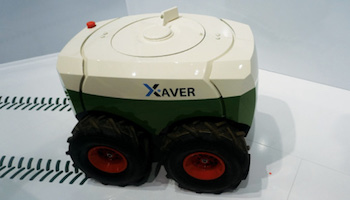
PRECISION TRENDS. One of the more popular debuts at Agritechnica 2017 in Hannover, Germany, was Fendt’s Xaver autonomous seeding unit. Programming a “swarm” of 12-15 of the robotic machines is to the performance of one standard 8-row corn planter.
According to Johannes Lehmann with Fendt, 12-15 units are comparable to the performance of one standard 8-row corn planter and 10 Xaver units can plant about 2.5 acres per hour. The units are automated to refill and recharge batteries, which takes about a half-hour.
“There is a background app that calculates different variables, including field size and other machines running the field to avoid overlaps and overplanting,” Lehmann says.
The prototype units are being field tested in 2018 with scheduled commercial production in 2020.
Following are additional new products introduced during Agritechnica. You can also find video interviews from the show by clicking here.
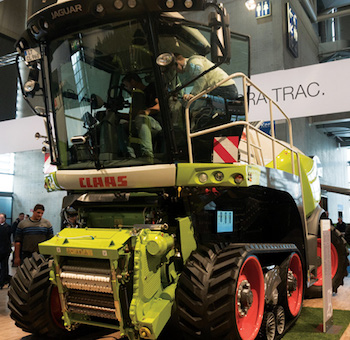 |
|
Claas' Jaguar Forage Harvester The Jaguar forage harvester from Claas is now available in Europe with the Terra Trac crawler track system and will be coming to North America in 2020. When the machine is turning, it is supported on middle support rollers, thereby raising part of each crawler track, explains Bob Armstrong. As a result, the contact area and degree of soil pressure change briefly to a level comparable to that obtained with 800-size tires.
|
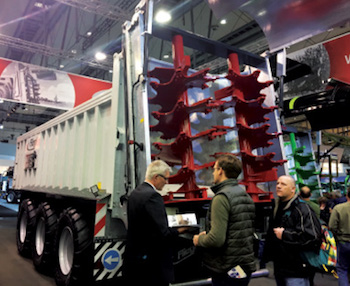 |
|
Fliegl’s ASW Fliegl’s ASW is a versatile push-off trailer that can be easily converted to serve different purposes depending on what attachment is being used. “What makes this a special product is it’s like a Lego set,” says Ed Reichling. “I can go from vertical beaters to grain auger cart. I can go to sugar beets. I can switch to potatoes. I can go to woodchips. There are over 30 different attachments that go on the back of the ASW.” He adds that the attachments can be switched out easily with a pallet fork in 10 minutes. Fliegl is currently working to build its dealer network in the U.S.
|
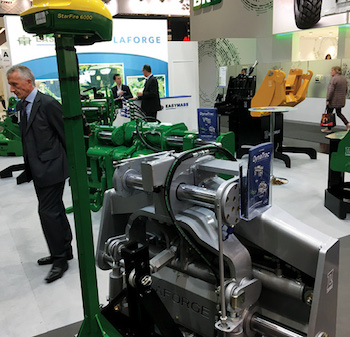 |
|
Laforge's Dynatrac Classic System For the last 2 planting seasons, in North America Laforge has offered its Dynatrac Classic system that replaces the 2-point drawbar on a pull-type planter or strip-till rig. During Agritechnica, the company introduced the 3-point version of the same concept — the Dynatrac Premium system (pictured). It handles both pull-type and 3-point mounted equipment on tractors up to about 200 horsepower, says Lars Paulson. The Dynatrac Ultima is PTO compatible and handles tractors up to 400 horsepower. “The beauty of our guidance system is instead of putting the guidance in the implement itself, we make a smart, quick coupler. These systems are plug-and-play with John Deere guidance system and with Trimble. The 3-point guidance systems will also work with pull-type and 2-point mounts, so they are universal as opposed to the what we’ve had with the Classic System where you’ve needed adapters to run anything else besides a 2-point planter,” he says.
|
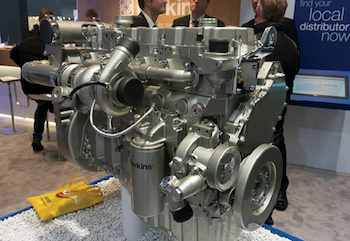 |
|
Perkins' EU Stage V Engines During Agritechnica, Perkins introduced the first of its EU Stage V engines. Stage V emissions standards will be phased in, starting in 2019 in Europe. Perkins’ Stage V technologies include common rail fuel systems, selective catalytic reduction (SCR), diesel oxidation catalysts (DOC) and diesel particulate filters (DPF). The company will offer engines from 12-630 horsepower, and all Stage 5 engines are also available as Tier 4, says James Schnuriger. The Perkins 1700 Series (shown here) is a 9.3 liter engine. The 6 cylinder is a turbocharged after-cooled unit with direct injection and a fully electronic control system. It has a power range of 335-456 horsepower, making it ideal for ag applications. Perkins is currently investing in building up the North American market, including a new engineering and manufacturing facility in Seguin, Texas.
|
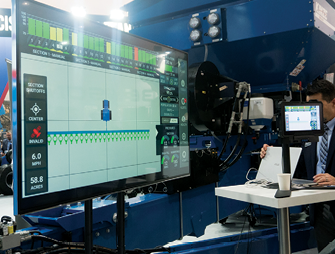 |
|
Kinze Electronic Group Display The Kinze Electronic Group has developed a rugged, tablet style display that was designed and developed from the ground up by Kinze for its planters, says Phil Jennings. “It was just time to do it ourselves,” he says. “We wanted something anyone can walk in and use. All the information can be found on one screen.” The display will make its North American debut at the National Farm Machinery Show in February. It features row-by-row mapping and an optimized plant screen layout that provides critical planting parameters and control.
|
 |
|
Enorossifeature's Maximus Rake The new Maximus Rake by Italian manufacturer, Enorossifeature independent rake wheel arms with a unique double-rod spring system to maintain constant down-pressure. Equipped with a heavy-duty frame and wide spacing between wheels and tires, The Maximus Carted V-Rake is ideal for heavy conditions. Available in 12 and 14 wheel configurations, the Maximus Rake comes with optional kicker wheel kit and conversion kit to convert the 12 wheel rake to a 14 wheel rake.
|
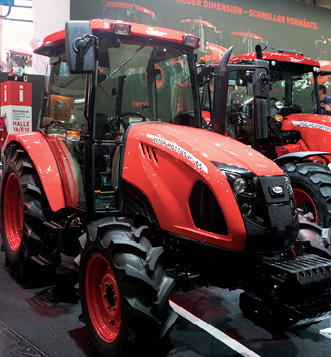 |
|
Zetor's Major Model Range Zetor unveiled its new line of utility tractors during Agritechnica. The Major HT 45, Major HT 55 and Major HS 65 are an extension of the Major model range and will be introduced in North America during the National Farm Machinery Show in Louisville in February. Production is scheduled to begin in Europe Jan. 1, 2018 and North American production will begin in the summer of 2018. The new line also introduces a new styling to Zetor tractors, which Vladimir Blaskovic, president of Zetor North America, says will be carried through the full line in the future. The manufacturer is focusing on growing its North American dealer network in 2018, with a goal of adding 30-40 dealers over the next 2 years. |
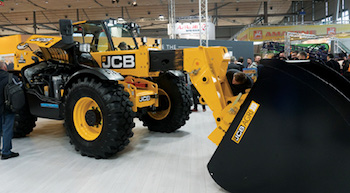 |
|
JCB's Loadall Telehandler JCB is celebrating the 40th Anniversary of the Loadall telehandler. A limited run anniversary edition will be available with a special paint scheme for 2018. New to the line, the Loadall 560-80 Agri Pro is likely to be popular in the U.S. because of its high lifting capacity, the company says. It features the new DualTech variable transmission, which JCB says is the world’s first 2-in-1 transmission. It combines the high-speed efficiency and towing capability of a JCB Powershift transmission with the low speed control advantages of hydrostatic drive. Other features include a 145 horsepower JCB engine, a 360 degree lighting package including LED road lights and a hydraulic hand break that is more comfortable and effective. |

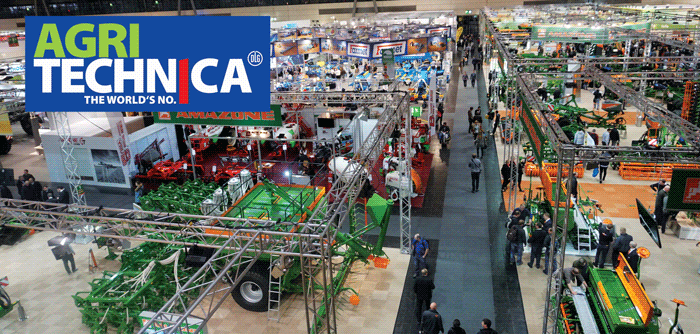
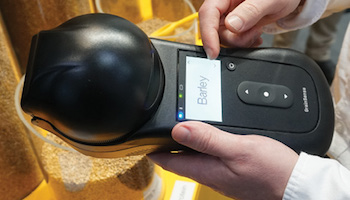
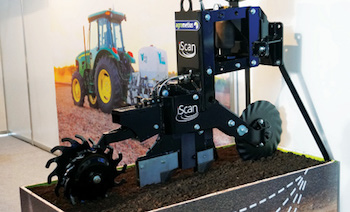
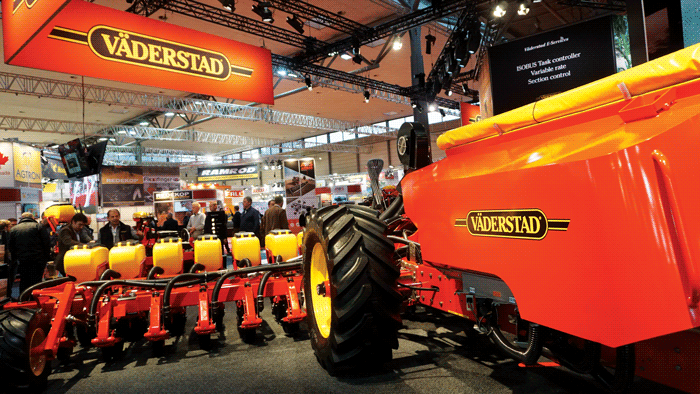






Post a comment
Report Abusive Comment